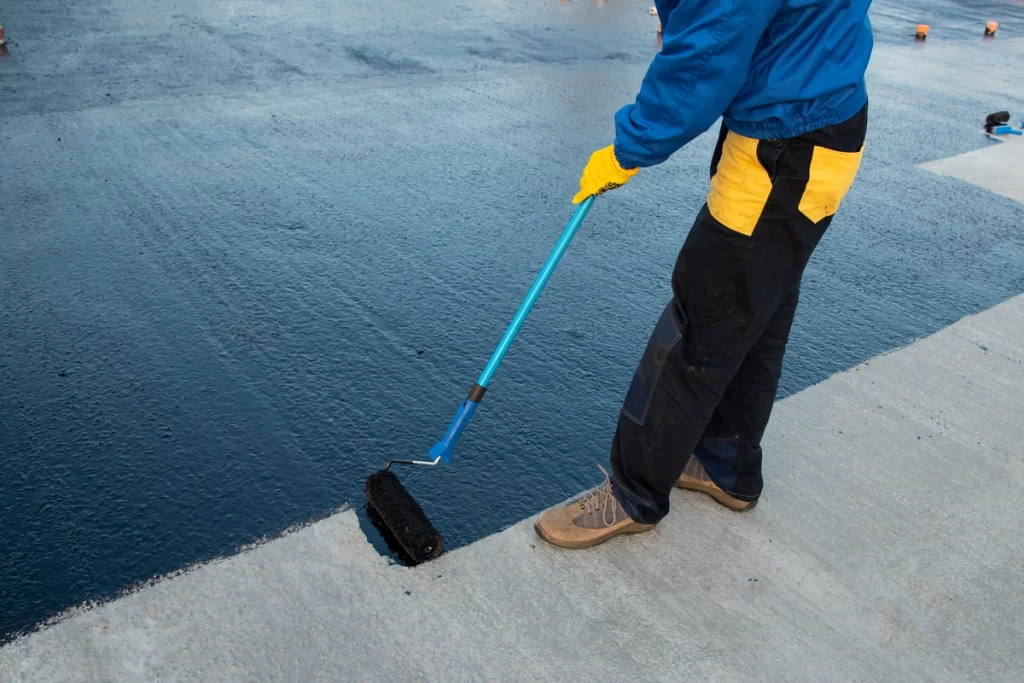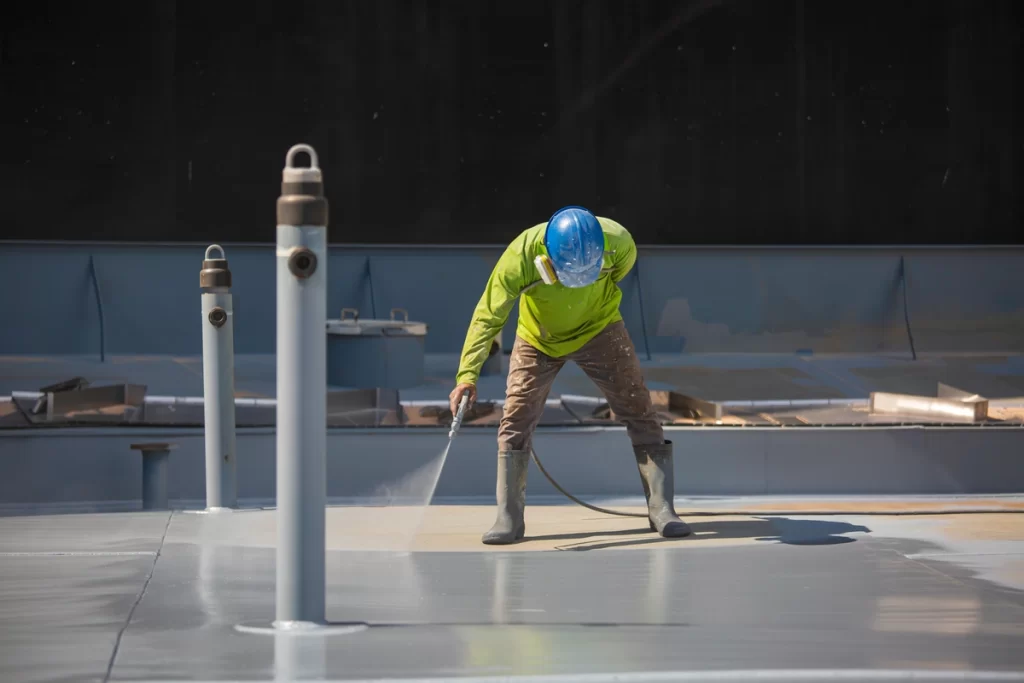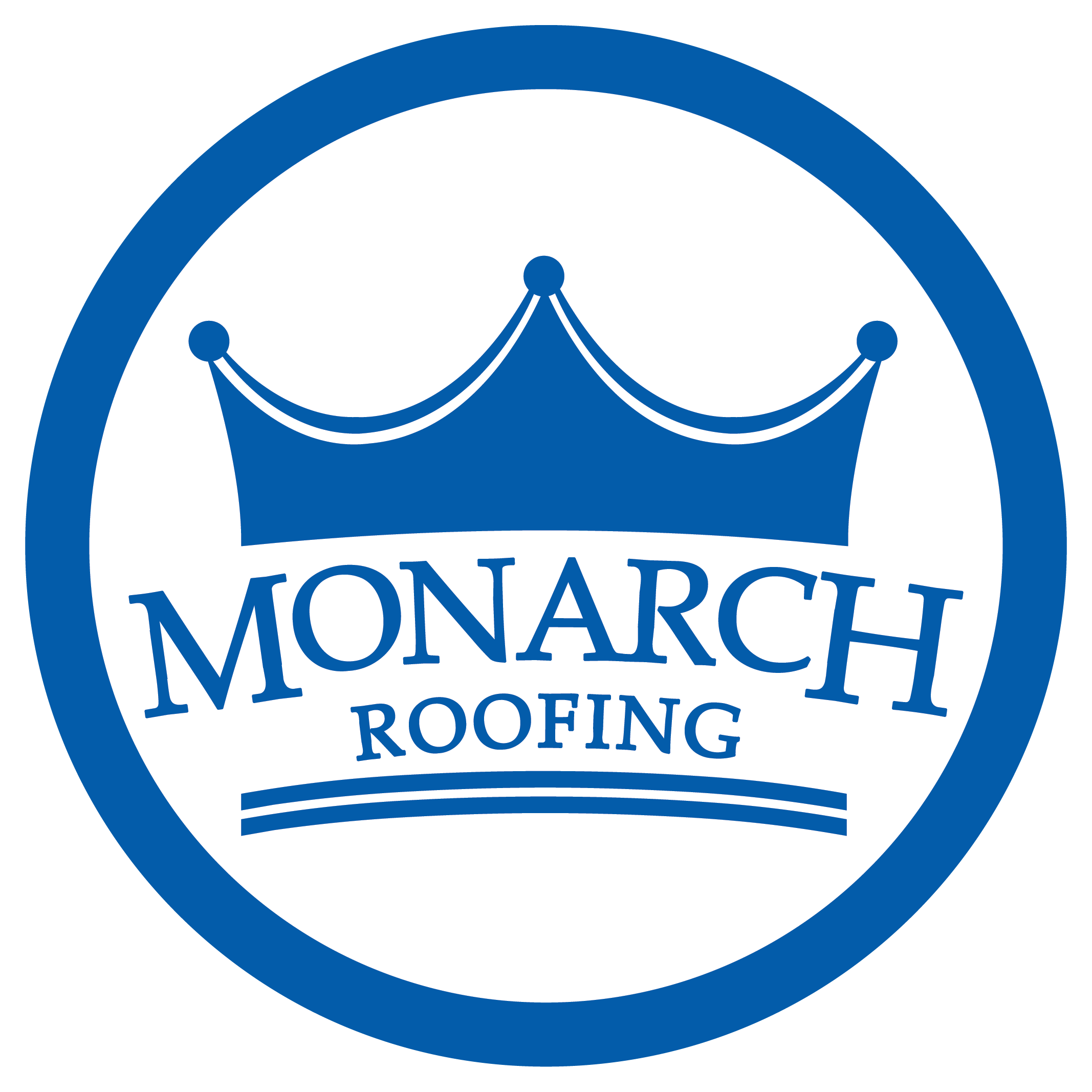Maintaining a strong and durable roof is essential to the longevity and integrity of any building. With growing awareness around sustainability and cost efficiency, roof coatings have become an increasingly popular solution. Roof coatings can extend the life of your roof, enhance its performance, and contribute to energy savings.
This thorough guide will cover everything you need to know about roof coatings, including their:
- Benefits
- Types
- Application processes
- Maintenance tips
What Are Roof Coatings?

Roof coatings are protective layers applied to the surface of a roof to enhance its durability and performance. These coatings can be applied to various roofing materials, including metal, asphalt, and single-ply membranes. They are designed to provide waterproofing, UV protection, and improved insulation.
⭐️ Main Benefits of Roof Coatings
- Extended Roof Life: By protecting the underlying roofing material from weathering and degradation, roof coatings can significantly extend the lifespan of your roof.
- Energy Efficiency: Reflective roof coatings can reduce the amount of heat absorbed by your roof, leading to lower cooling costs and improved energy efficiency.
- Cost Savings: Roof coatings can delay the need for expensive roof replacements and reduce maintenance costs.
- Environmental Impact: By extending the life of your existing roof, coatings can reduce waste and contribute to more sustainable building practices.
- Improved Aesthetics: Roof coatings can refresh the appearance of your roof, giving it a clean and uniform look.
4 Types of Roof Coatings
There are several types of roof coatings available, each with its unique properties and advantages. The most common types include acrylic, silicone, polyurethane, and asphalt-based coatings.
1) Acrylic Roof Coatings
Acrylic roof coatings are water-based and known for their excellent UV resistance and reflectivity. They are commonly used on metal and single-ply roofs.
- Advantages:
- High reflectivity
- UV resistance
- Easy application
- Cost-effective
- Disadvantages:
- Limited ponding water resistance
- Shorter lifespan compared to silicone and polyurethane coatings
2) Silicone Roof Coatings
Silicone roof coatings are solvent-based and offer superior water resistance and UV protection. They are ideal for roofs with ponding water issues.
- Advantages:
- Excellent water resistance
- UV stability
- Long-lasting
- Flexible in extreme temperatures
- Disadvantages:
- Higher cost
- Slippery surface when wet
3) Polyurethane Roof Coatings
Polyurethane roof coatings are known for their durability and resistance to impact and abrasion. They come in two main types: aromatic and aliphatic.
- Advantages:
- High durability
- Impact and abrasion resistance
- Suitable for high-traffic areas
- Disadvantages:
- Higher cost
- Requires professional application
4) Asphalt-Based Roof Coatings
Asphalt-based roof coatings are traditional and widely used for built-up roofs and modified bitumen systems. They offer good waterproofing properties.
- Advantages:
- Cost-effective
- Good waterproofing
- Easy to apply
- Disadvantages:
- Limited UV resistance
- Shorter lifespan compared to other coatings
Step-by-Step Application Process

Proper application of roof coatings is crucial to ensure their effectiveness and longevity. Here’s a step-by-step guide to the application process:
Step 1: Inspection and Preparation
Before applying a roof coating, it’s essential to inspect the roof for any damage or issues that need to be addressed. Clean the roof thoroughly to remove dirt, debris, and any loose material. Repair any cracks, seams, or damaged areas to create a smooth and stable surface for the coating.
Step 2: Priming (If Necessary)
Some roof coatings require a primer to improve adhesion and performance. Check the manufacturer’s recommendations to determine if a primer is needed. Apply the primer evenly and allow it to dry completely before proceeding.
Step 3: Application of Roof Coating
Using the appropriate tools (brush, roller, or sprayer), apply the roof coating evenly across the entire surface. Ensure that the coating is applied at the recommended thickness to achieve optimal protection and performance. Multiple coats may be necessary, depending on the product and roof condition.
Step 4: Curing and Inspection
Allow the roof coating to cure as per the manufacturer’s instructions. This typically involves a drying period of several hours to days, depending on the type of coating and weather conditions. Once cured, inspect the roof to ensure that the coating has been applied evenly and covers the entire surface.
Maintenance and Care
Regular maintenance and care are essential to ensure the longevity and effectiveness of your roof coating. Here are some maintenance tips:
- Regular Inspections: Conduct regular inspections of your roof to identify any signs of wear, damage, or deterioration. Look for cracks, blisters, or areas where the coating may be peeling or thinning. Address any issues promptly to prevent further damage.
- Cleaning: Keep your roof clean by removing debris, leaves, and dirt that can accumulate over time. Use a soft-bristle broom or a low-pressure washer to clean the surface without damaging the coating.
- Recoating: Over time, roof coatings can wear down and lose their effectiveness. Depending on the type of coating and environmental conditions, you may need to recoat your roof every 5-10 years. Regular inspections will help you determine when it’s time for a recoat.
Frequently Asked Questions (FAQs)
We’ve got all of the details that you need to know about roof coating. Check out and see if your question is below!
How long do roof coatings last?
The lifespan of a roof coating depends on the type of coating, environmental conditions, and maintenance practices. On average, roof coatings can last between 5-15 years.
Can roof coatings be applied to any roof?
Roof coatings are versatile and can be applied to various roofing materials, including metal, asphalt, and single-ply membranes. However, it’s essential to choose the right type of coating for your specific roof type and condition.
Are roof coatings environmentally friendly?
Many roof coatings are formulated with environmentally friendly materials and can contribute to sustainability efforts by extending the life of your existing roof and reducing waste. Reflective coatings can also improve energy efficiency and reduce cooling costs.
How do I choose the right roof coating for my roof?
Consider factors such as your roof type, climate, budget, and specific needs (e.g., water resistance, UV protection) when choosing a roof coating. Consulting with a roofing professional can help you make an informed decision.
Can I apply roof coatings myself?
While some roof coatings can be applied as a DIY project, others may require professional application to ensure proper adhesion and performance. Always follow the manufacturer’s instructions and consider consulting with a roofing professional if you’re unsure.
Protect Your Roof With Monarch Roofing
Roof coatings are an excellent investment for extending the life of your roof, enhancing its performance, and improving energy efficiency. By understanding the different types of roof coatings and following proper application and maintenance practices, you can enjoy the benefits of a well-protected and durable roof.
Ready to get started? Explore our range of high-quality roof coatings and find the perfect solution for your roofing needs. Contact our experts at Monarch Roofing for personalized recommendations and professional application services.
Remember, a well-coated roof is a resilient roof. Protect your investment with the right roof coating today!





